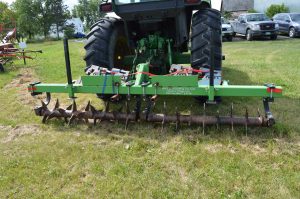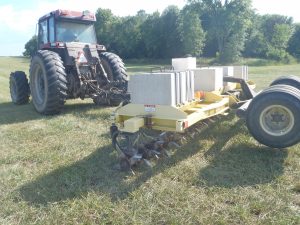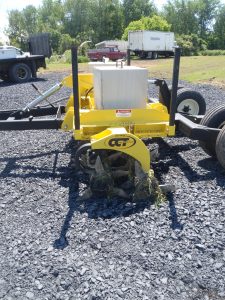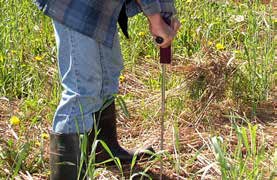Final Report for ONE14-202
Project Information
In the Champlain Valley of Vermont, Vergennes and Covington clay soils used for grass hay production are subject to soil compaction over time as equipment travels over the crop for multiple passes for maintenance and harvest operations. Three field sites were selected in Bridport and Addison, VT, to impose repeated aeration tillage treatments using a GenTill aerator, a single-axle Aerway, or a double-axle Aerway aerator tillage implement. Data was collected in 2014, 2015 and for the first cut of 2016 at the Addison site; and 2014 and for the first cut of 2015 at the Bridport site. Forage samples were submitted to Dairy One Forage Testing Laboratory for complete NIR forage analysis. Soil samples were submitted to UVM Agricultural & Environmental Testing Lab for complete basic soil test analysis, and to Cornell Soil Health Test Lab for evaluation of physical, biological and chemical properties to evaluate overall soil health quality and constraints.
Grass hay yields at the Bridport site were not significantly affected in 2014 following aerator tillage, but then resulted in 2015 first cut hay dry matter yield increases of 28% for single-axle and 11% for double-axle Aerway tillage treatments. Grass hay yield at the Addison site increased 38% by using aeration tillage in 2014. The 2015 growing season was unusually wet in June with over 8.5” of rain. Soil compaction at the Addison site was reduced by 4% and water holding capacity increased by 7% in the aerated plots compared to non-aerated plots. The aeration tillage schedule was changed in 2015 and 2016 to wait until after the first harvest in early June and the risk of compaction was much less, due to drier soil conditions.
Initial soil health assessments indicate that these clay soil sites have high priority constraints of surface hardness (compaction) and suboptimal functioning of available water capacity. Increasing late summer soil moisture holding capacity of clay soils is one goal that local farmers are seeking as farmers in this locale experience a late season drought nearly every summer.
The total cost per acre for operating an aerator machine is roughly $5/acre per pass and three times per year (after each cut) would be $15. At $4/ bale, a yield increase of 4 bales per acre per year would justify the use of the aerator.
The combined improvements to soil condition by decreasing soil compaction and increasing water holding capacity by repeated aeration tillage at the proper time does provide improved field conditions that allow for increased potential crop yields. However, aeration tillage during saturated soil conditions may increase compaction and be detrimental to soil condition.
Introduction:
Permanent hay fields can be a reliable source of income for farmers if kept productive over a long period of time. Compaction due to harvest activities can cause anaerobic conditions and poor water infiltration that contribute to productivity declines over time. Aerator machines that cut slots into the soil surface have long been used to alleviate surface soil compaction. However, local data on yields and long term viability of permanent hay fields as a result of consistent use of an aerator on clay soil does not exist. The Champlain Valley Crops, Soil, & Pasture Team investigated the potential benefits of regular and consistent aerator use on permanent hay fields on the farms of Doug Gould in Addison and Henry Lawton in Bridport. The trials focused on aerator machine use versus no use (control) at the Addison site, and a double axel aerator machine versus a single axel aerator machine versus no use (control) at the Bridport site. Due to a change in farm plans the Bridport site only participated in 2014. The Addison site participated for 2014 through 2016.
Three field sites were established on Vergennes clay soil in Bridport and Addison to measure aeration tillage effects on grass hay yield and soil health quality in the typical clay soils that farmers manage in the Champlain Valley.
The Bridport site received one year of aeration treatments (3) and yield data collection continued through first crop harvest in the second year to evaluate residual effects on crop yields.
The Addison site aeration tillage was repeated for two years and yield data corresponds with each individual harvest during 2014, 2015 and first harvest in 2016. Soil health and basic soil test sampling was completed at the end of the growing season in 2015 for comparison with previous year results. The farmer has expanded use of aeration tillage to include entire farm.
A farmer field day was held in the summer of 2016 to highlight the project and results at the Addison site, including a demonstration of two aerator machines. There were 14 attendees including farmers, researchers and industry professionals.
Cooperators
Research
Aeration tillage at the Addison site was done with a GenTill aeration toolbar, mounted on the 3-point hitch of the tractor. The two fields were aerated four times in 2014 and three times in 2015. Total aeration treatments have been implemented eight times from fall 2013 through fall 2015 (2013-1x, 2014-4x, 2015-3x). In 2015, the early spring treatment was eliminated due to concern about causing compaction during wet soil conditions. In 2015 the first aeration tillage was performed after the first hay harvest in June.
 Fig.1: GenTill aerator
Fig.1: GenTill aerator
Aeration at the Bridport site involved a comparison between a conventional single axel Aerway aerator and a double axel Aerway aerator. The field was split into three treatments: control (no aeration), single axel aeration, and double axel aeration. The aeration treatments. were performed after first cut and second cut. Due to a change in farm plans, the Bridport site did not continue to participate after 2014.
Yields were measured at both sites before each harvest. Sampling was done using a hand operated hedge trimmer and a quadrant measuring 1.5 square feet. Four subsamples per sample were taken for wet weight. Samples were then sent to the Dairy One lab for moisture and basic forage analysis. All yields are reported as 100% dry matter.
Aerator Description
The two brands of aerators used in the project, GenTill (see Fig.1) and AerWay (see Fig.2), are very similar but have several key differences in their design. Both machines consist of rollers with sets of 8” tines spaced 7.5” apart. The key design similarity is that both manufacturers have angled tines to achieve a ‘lift and twist’ action that is designed to move soil laterally, fracture soil, and penetrate up to 8 inches. The following chart highlights the major differences:
|
|
Aerway |
GenTill |
|
Number of tines per hub |
4 |
3 |
|
Fractures (slots) per acre |
More tines per roller create more slots and soil fracturing per acre |
Less tines per roller create fewer slots and soil fracturing per acre |
|
Ballast required |
More tines entering the soil require more weight to ensure full penetration, and more tractor horsepower to pull |
Only one tine per roller is attempting to enter the ground at a time, resulting is less weight required for full penetration, and less tractor horsepower to pull |
|
Maintenance |
Bolt on tines are easy to replace, however are susceptible to breakage and wear |
One piece set is resistant to wear, however is labor intensive to replace |
 Fig.2: Single-axel AerWay aerator
Fig.2: Single-axel AerWay aerator
This project explored the use of both machines as aerators, but they are capable of being used as a vertical tillage implement. Both manufacturers offer adjustable swing arms to change the angle of the gangs of tines. This allows the aerators to engage the soil more aggressively and create more soil fracturing and lateral soil movement as the offset angle is increased. Vertical tillage is typically used in minimal-till and no-till annual crop rotations to relieve compaction, manage crop residues, and warm and loosen the seedbed. Both manufacturers offer attachments such as coulters and rolling baskets for their aerator machines that will be used as vertical tillage implements.
 Fig.3: Tandem-axel AerWay aerator
Fig.3: Tandem-axel AerWay aerator
AerWay offers a machine with two sets of rollers (tandem axel) that have three tines per hub for even more slots and fracturing than any single axel machine (see Fig.3). This was the machine trialed at the Bridport site that showed a yield decrease as compared to the single axel AerWay. The increased number of slots had an apparent negative impact on yield. Also, the tandem axel machine requires more horsepower to pull and more ballast for full penetration than single axel machines of the same width. This tandem-axel machine would be very effective as a vertical tillage implement and, in fact is intended by AerWay for that purpose.
Measuring Compaction with a Field Penetrometer
 Fig.4: Using penetrometer to measure compaction
Fig.4: Using penetrometer to measure compaction
Soil samples were collected from each treatment block in November 2015 and sent to Cornell Soil Health Test lab for analysis. Compaction is measured (in psi) with a field penetrometer pushed through the soil profile. A penetrometer is an instrument that measures soil resistance to penetration. It consists of a cone tip, a metal shaft, and a gauge that measures resistance in pounds per square inch (psi). Most penetrometers come with two different size tips and the gauge has two corresponding scales. It is important to read the appropriate scale for the tip being used. Penetrometer readings should be taken when soil moisture is at field capacity (2-3 days after free drainage). The level of soil moisture can greatly affect the measured values by affecting the ease with which penetrometer enters the soil.
When taking a measurement, slow even pressure is applied so the probe enters the soil at a rate of 4 seconds per 6 inches or less (see Fig.4). The highest pressure reading is recorded at two depths (surface: 0-6” and subsurface: 6-18”). For each plot, eight readings are taken and averaged for a final surface and subsurface reading.
Addison Site
The two field sites in Addison at the Gould Farm received three aeration treatments in 2015 after each of the first, second and third hay harvests in June, August and November. The early spring aeration was not done this year because of concerns that the early spring aeration in April of 2014 decreased yields due to slot sidewall compaction in wet soils. The late fall aeration scheduling replaces the early pre-season spring aeration treatment that was originally planned for each year.
In 2016, treatments measured at the Addison site were control, aerated one year (2014), and aerated two years (2014-15). The 2015 growing season was unusually wet in June with over 8.5” of rain. The aeration appears to have negatively affected yield in the saturated conditions of that growing season (see chart 2). The negative affect on yield carried over to 2016 (see chart 1). It is well known that clay soil is susceptible to compaction under saturated conditions, and these results are a prime example of that.
In 2014 and 2015, fertilizer was applied in early spring and after each of the hay harvests. In 2016, fertilizer was applied in the early spring and in September. Each field received 25 lb/ac N in April at early spring growth using a 30-5-10 analysis fertilizer broadcast applied at 85 lb/ac. After first hay harvest an additional 30 lb/ac N was applied to both fields using a combination of 30-5-10 (52 lb/ac) plus Urea 46-0-0 (52 lb/ac). One field (DG1) received a third application of fertilizer (30-5-10) at 52 lb/ac after a third harvest was taken. Total maximum annual nutrients applied was 84 lb/ac N, 10 lb/ac P2O5, and 20 lb/ac K2O, which was less than UVM soil test recommendations. In 2016, fertilizer was applied to raise soil test levels of phosphorus and potassium to optimum.
The farmer tracked field activities by recording fertilization, aeration tillage and hay harvest information on a field-scale basis. Aeration tillage in the fields was guided and recorded by using a AFS FM-750 GPS steering guidance display for agricultural equipment.
Crop yields were measured by two separate methods for each harvest. The farmer counted harvested dry bales of hay for each harvest, and Extension field staff collected multiple 1.5 square foot quadrat samples that were clipped from each treatment area, weighed and a composite sample sent to Dairy One Forage Testing Laboratory for a complete NIR forage analysis to determine forage characteristics for nutrient uptake.
Cornell Soil Health Test results were used to evaluate soil compaction. Measurements were taken in the fall of 2014 and 2015; and in the spring of 2016. In 2014 and 2015, aeration was compared to no aeration. In 2016, there were plots that had been aerated one year, two years, and not at all (See chart 3).
Surface compaction was not observed to be different as a result of the aeration treatments. Subsurface compaction showed a slight increase under aeration, however aeration tillage is not expected to change soil compaction at that depth. One possible explanation for the surface compaction results is timing of the aeration treatments. The early spring treatment seems to have done more harm than good to surface compaction. Soils tend to be wet that time of year and an extra pass will have caused more compaction. Conversely, the late fall treatment may have opened the ground up to allow freeze/thaw cycles during the winter to further alleviate compaction.
Starting in 2015, the early spring treatment was eliminated, partially explaining the compaction results. Also, soil moisture has an effect on penetrometer results and the wet conditions during 2015 may have skewed the results; while the drier, more normal conditions in early 2016 may be reflected in the results. Also, ‘slot effect’, when a penetrometer measurement is taken in a former slot that is no longer visible, may skew the results. Overall, these results show that properly timed aeration can help alleviate surface compaction; still, care must be taken not to aerate during wet soil conditions.
Bridport Site
The one field site in Bridport did not receive any aeration tillage treatments in 2015. The single-axle and double-axle aerator treatments were done three times in 2014 after a spring application of 2 ton/ac composted chicken manure. In 2015, first cut hay was sampled using quadrat sampling to determine dry matter yields and forage quality measures. The first cut harvest yields were measured to determine any carryover effect from the treatments imposed in 2014.
Grass hay yields at the Bridport site were not observed to be affected in 2014 following aerator tillage, but then resulted in 2015 first cut hay dry matter yield increases of 28% for single-axle and 11% for tandem axel (T-axel) Aerway tillage treatments (see chart 4).
There were no apparent yield differences at the Bridport site comparing a single axle Aerway or the double-axel Aerway with the control treatment. The aeration tillage was more aggressive in disturbing soil at this site than at the other site using a different type of aerator. In 2015 the first cut hay crop was greater than the control by 28% in the single axle Aerway treatment area, and 11% in the double-axle Aerway treatment. No additional fertilizer was applied in 2015, so yield increase from aeration tillage was a reflection of carry-over effect from the previous year treatments on soil yield potential. The Bridport site was discontinued after this harvest because the farmer did not want to continue the aeration tillage with concerns about expense of tillage operation and damage to the grass sod.
Aeration tillage at the Addison site was done with a GenTill aeration toolbar three times in 2015. Total aeration treatments have been implemented eight times from fall 2013 through fall 2015 (2013-1x, 2014-4x, 2015-3x). Dry matter (DM) hay yields in 2014 at the Addison site were increased 37% and 40% in fields DG1 and DG4 respectively by using aeration tillage.
In 2015 there was only a 1% overall increase in the harvested yields between aerated and non-aerated plots. 2015 was very wet in June with over 8.5” of rain which compounded the low fertility regime used by the farmer leading to overall reduced yields. Increasing fertilization rates to meet UVM recommendations (150 lb/ac N) may have produced improved yield results.
At the end of the 2015 crop season, soil compaction in the four aerated field plots was reduced by 4% in the 0 to 6-inch depth range and by 3% in the 6 to 18-inch depth range. The soil moisture content (mc) in the aerated plots was 7% greater than in the non-aerated plots, 35% mc v 32% mc, indicating a greater capacity to infiltrate and hold plant available water. The combined improvements to soil condition of decreased soil compaction and increased water holding capacity should provide conditions that allow for greater yield potential. The increase in soil moisture holding capacity is one goal that local farmers are seeking as Addison County experiences a late season drought nearly every summer.
The project was extended into the 2016 season to see if there were any long term effects from the 2014 and 2015 aeration treatments. The one-year treatment (2014 aeration) resulted in a 3.5% reduction in surface compaction; while the two-year treatment (2014 and 2015 aeration) resulted in a 4.5% reduction in compaction. There is reason to believe that if aerations were continued during proper conditions (field capacity or drier) that the surface compaction would improve.
The farmer at the Addison site, Doug Gould, used the FM-750 GPS steering guidance unit that we provided to track aeration tillage activities in the field. As a result, he has purchased his own GPS guidance system to use while aerating or during fertilizer application to improve field efficiency of machinery operations. Doug feels this aeration of the soil is very beneficial and he has extended use of this repeated aeration tillage management to include all acreage on his farm.
Education & Outreach Activities and Participation Summary
Participation Summary:
On August 2, 2016, a farmer field day was held to highlight the project and results at the Addison site, including a demonstration of two aerator machines. There were 14 attendees including 4 farmers and 10 researchers and industry professionals. The two machines were the GenTill brand aerator owned by the farmer and Aerway brand aerator rented out by the local conservation district. The handout titled “Aeration Tillage & Precision Ag Field Day” was distributed to all attendees with presented our results and information about aeration tillage and the precision agriculture equipment (GPS unit) used by our participating farmer, Doug Gould. (See attachment 1: Handout_fieldDay2016_Gould). There was good discussion among all those in attendance about the pros and cons of aerating, as well as equipment and tractor requirements.
- Attachment 1: Handout_FieldDay2016_Gould
Also, the article “Aeration Tillage: Effects on Hay Yield and Soil Compaction” was published in the Fall 2016 Edition of the Champlain Valley Crops, Soils, and Pasture Team newsletter. (See Attachment 2: CV-CropSoil-Fall-News-2016). This newsletter is distributed through our email list to 797 farmers, industry professionals, and agency personnel; and hard copies are mailed to an additional 417 recipients.
- Attachment 2: CV CropSoil Fall News 2016 FINAL BOOKLET
Project Outcomes
The total cost per acre for operating an aerator machine is roughly $5/acre per pass. This includes fuel, lubricants, repairs, implement depreciation, interest and insurance. The total cost to aerate three times per year (after each cut) would be $15. At $4/ bale, a yield increase of 4 bales per acre per year would justify the use of the aerator. However, consistent yield increases as a result of aerating were not observed. It is possible that timing the aerator passes to avoid wet soil conditions may result in more consistent yield increases. Also, three passes may not be necessary to achieve the desired results, which would lower the operating expense. Over time, a properly managed aerating schedule could increase yields well above operating costs.
Farmer Adoption
Of the two farms that started the project in 2014, Doug Gould fully adopted aeration farm wide; while Henry Lawton stopped using his aerator machine after 2014 due to what he felt were a lack of results. Farmer adoption in the Champlain Valley is not widespread, however farms that rent the aerator from the Conservation District, for example, tend to be repeat customers. Reasons farmers give for continuing to aerate generally have to do with compaction relief and aiding in the incorporation of manure. An unexplored use in this area would be use of aerator machines as vertical tillage implements in reduced till and/or no-till scenarios. They can very effective at helping to level ruts after grain or forage harvest, cut up and distribute residue, and alleviating surface compaction when deep tillage is not practiced.
Areas needing additional study
Additional study into timing and frequency of aerations treatments would be the logical next step for use on permanent hay ground. As this study observed, early spring aeration and aeration during wet soil conditions potentially creates more compaction, rather than alleviating compacted conditions. Other areas not addressed in this project that merit additional study would be aeration to increase manure utilization and aerator use as a vertical tillage tool in row crop situations. In the Champlain Valley, it is common to aerate immediately before spreading manure to help reduce runoff and increase nutrient utilization. However, good data on the extent of these advantages is limited. The use of aerators as vertical tillage tools is not common in the Champlain Valley, however no-till farming is gaining acceptance and vertical tillage in general is not common. Aerators could be utilized on no-till corn, soybean, and small grain fields to provide many of the same benefits they do on permanent hay ground.